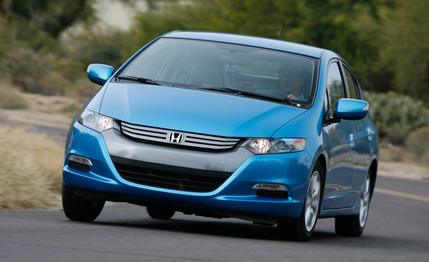
 Road Test
Road Test
Meet the “affordable hybrid.”
That’s a new item on your ever-expanding menu of hybrid choices. We’ve tested hyper-miler hybrids—the original three-cylinder Honda Insight at the dawn of this millennium, rated at 49 mpg city and 61 highway by today’s EPA methods—and “muscle-car” hybrids, the 5.5-seconds-to-60 Lexus GS450h. There have even been perplexing hybrids; Honda never was able to convince customers of the benefits of the 2005 Accord hybrid. All of the above were mileage makers, more or less, but none put a priority on affordability. Now Honda is turning that page with this five-door, five-seat Insight; it says the emphasis here is on bringing down the price of hybrid benefits more than pushing out the technical frontier.
While we wait for its price to be revealed, we expect the base Insight LX will slip in at less than $21,000, nearly $2000 below the 2009 Toyota Prius.
We’re also waiting for the official EPA fuel-economy ratings. Meantime, Honda projects 40 mpg city and 43 highway—no match for the Prius at 48 and 45, respectively. Your mileage may vary, of course, but our 128-mile test trip over suburban and rural blacktops netted an encouraging 46 mpg. (A footnote: Arizona’s temperate December climate means air conditioning was not used, nor were there engine starts at seriously cold temperatures.)
The 2010 Insight, at first glance, fits almost perfectly into the Prius mold. The body has the same high-tail fastback silhouette, surely dictated by aero drag considerations. At 172.3 inches, the Insight is nearly three inches shorter than the Prius, 2.5 inches lower, and about an inch narrower. The space inside, as expressed by EPA passenger volume, is substantially less than in the Prius (85 cubic feet versus 96) and makes for a tight back seat with limited headroom. But cargo volume, at 16 cubic feet, is larger by 10 percent.
So much for the similarities. The behavior of these two hybrids is very different. “Hondas must drive like cars,” one engineer explained to us, citing a very specific difference: When you key on the Insight, the engine always starts. But when you power up a Prius, a ready indicator will glow on the dash even though the engine may choose not to start if it’s already sufficiently warm. This difference goes back to each company’s fundamental ideas about hybrids. Toyota’s hybrid is more complex, is more costly to build, and is capable of higher fuel economy in urban driving. The payoff of that technology, in fact, is sufficient to boost the Prius’s city mileage above highway mileage; Honda’s hybrids, like conventional cars, do less well in metro motoring.
While Toyota hybrids readily move about at city speeds with the engine off, Honda’s arguably don’t. However, the Insight does slip into the “EV mode” quite often at low speeds, accomplished by closing all of the valves to prevent pumping losses and cutting off fuel flow through the injectors. Motive power in this mode is supplied by the electric motor acting on the crankshaft, which is still rotating and therefore adding the engine’s friction losses to the motor’s burden.
The necessity of “motoring” the engine whenever the Honda is in motion will inevitably cut into mileage. But if the overall vehicle price can be lower, which is the plan, the Honda way may be more appealing. The Insight is all about driving the price down where Toyota can’t profitably go.
For the record, the Insight drives like a Honda, with tight suspension motions, a firm ride, well-connected steering, and a no-fat musculature. Interior sound levels are mild and well controlled, especially at freeway speeds. Cockpit space is generous for two in front, a bit tight on the knees in back if front occupants are unwilling to compromise on legroom. The rear bench is high, firm, and exceptionally well shaped for lumbar support.